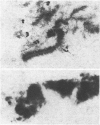Abstract
Cervical smears from 293 users of intrauterine contraceptive devices attending family planning clinics in East Fife, Dundee, and Angus were stained by Papanicolaou and Gram's methods and examined for actinomyces-like organisms. Of the 128 women using plastic devices, 40 gave smears positive for these organisms. In contrast only two positive smears were obtained from the 165 women using devices containing copper and none from a control group of 300 women taking oral contraceptives. Colonisation was more common in women whose plastic devices had been in situ for over two years. Correlations between the presence of these organisms and recorded incidences of pain and both clinical and cytological evidence of inflammation of the lower genital tract were highly significant (p = 0.00001, p < 0.00001, and p < 0.00001 respectively). The results suggest that plastic intrauterine contraceptive devices predispose to colonisation by actinomyces-like organisms, particularly after long-term use. Hence if the apparently bacteriostatic action of copper devices is confirmed these should probably be more widely used.
Full text
PDF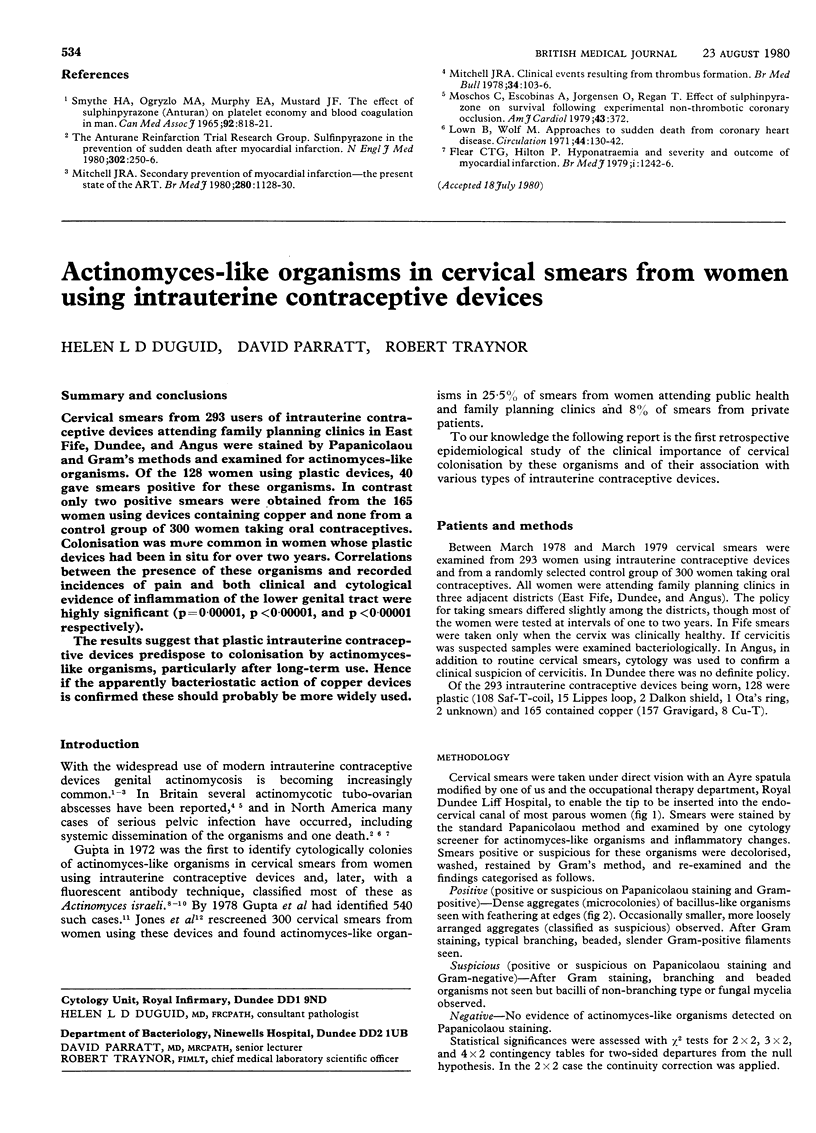
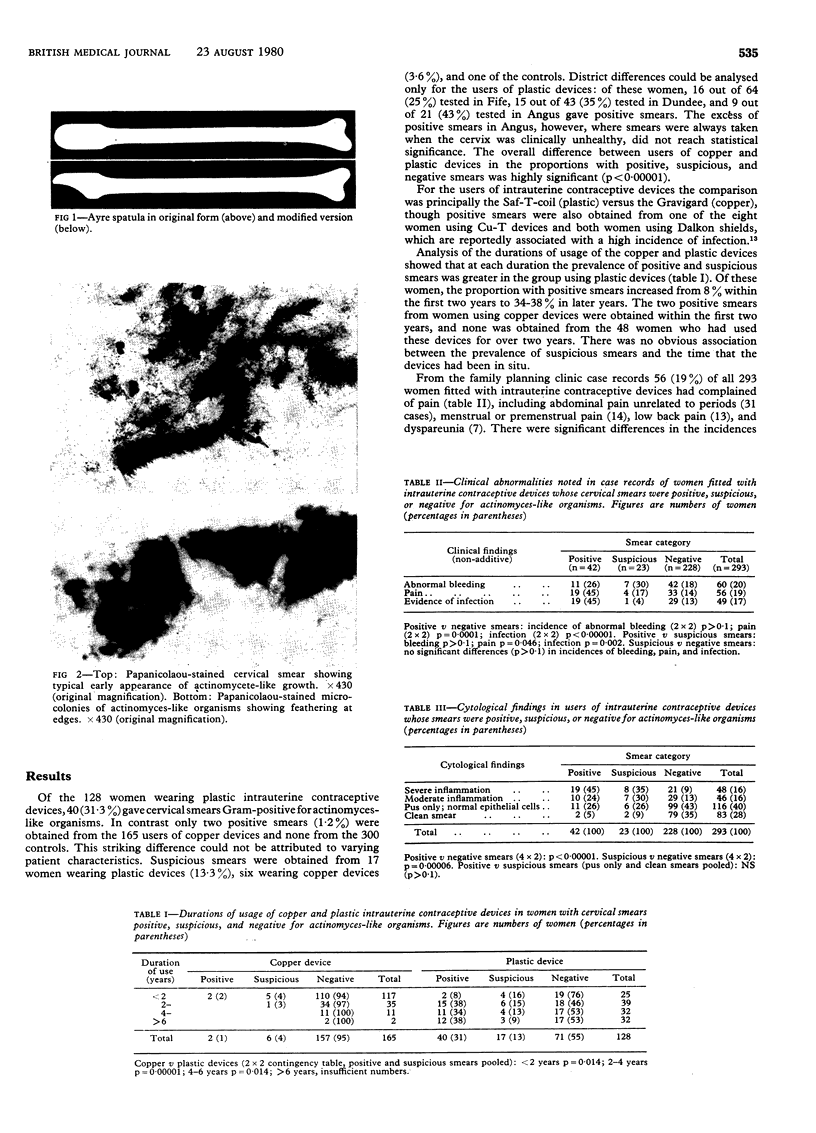
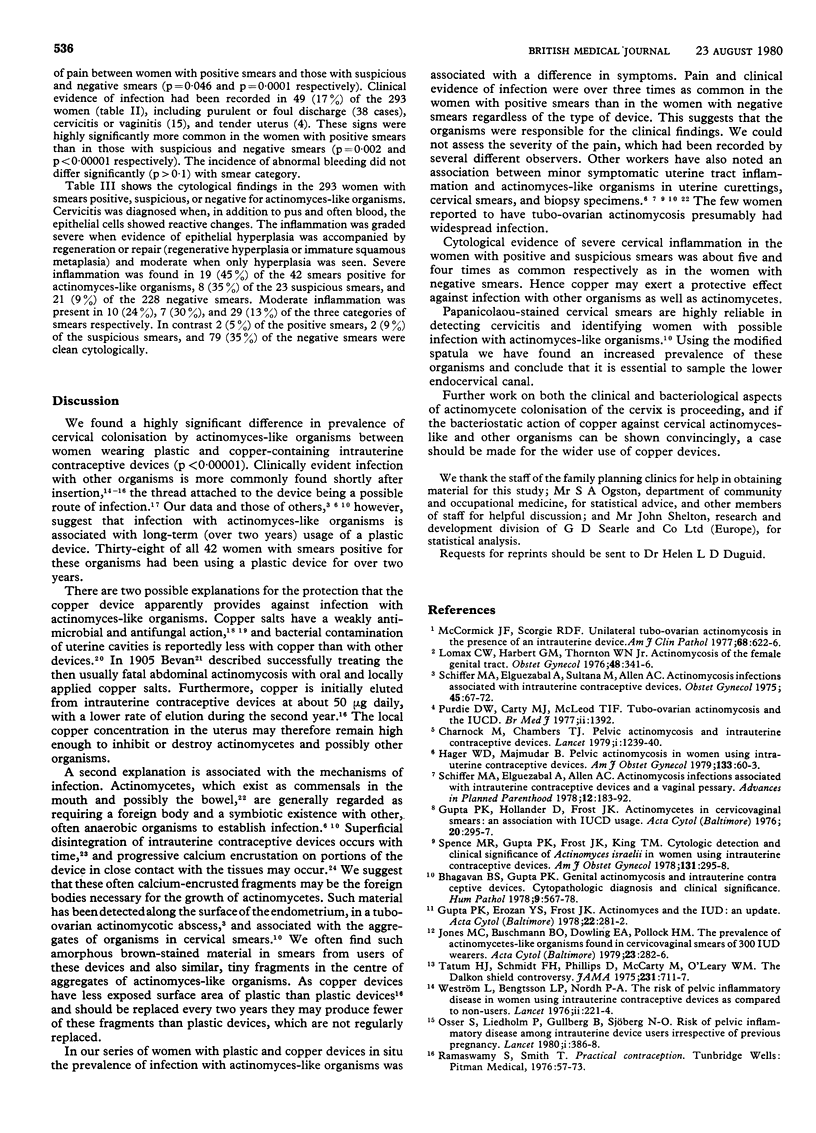
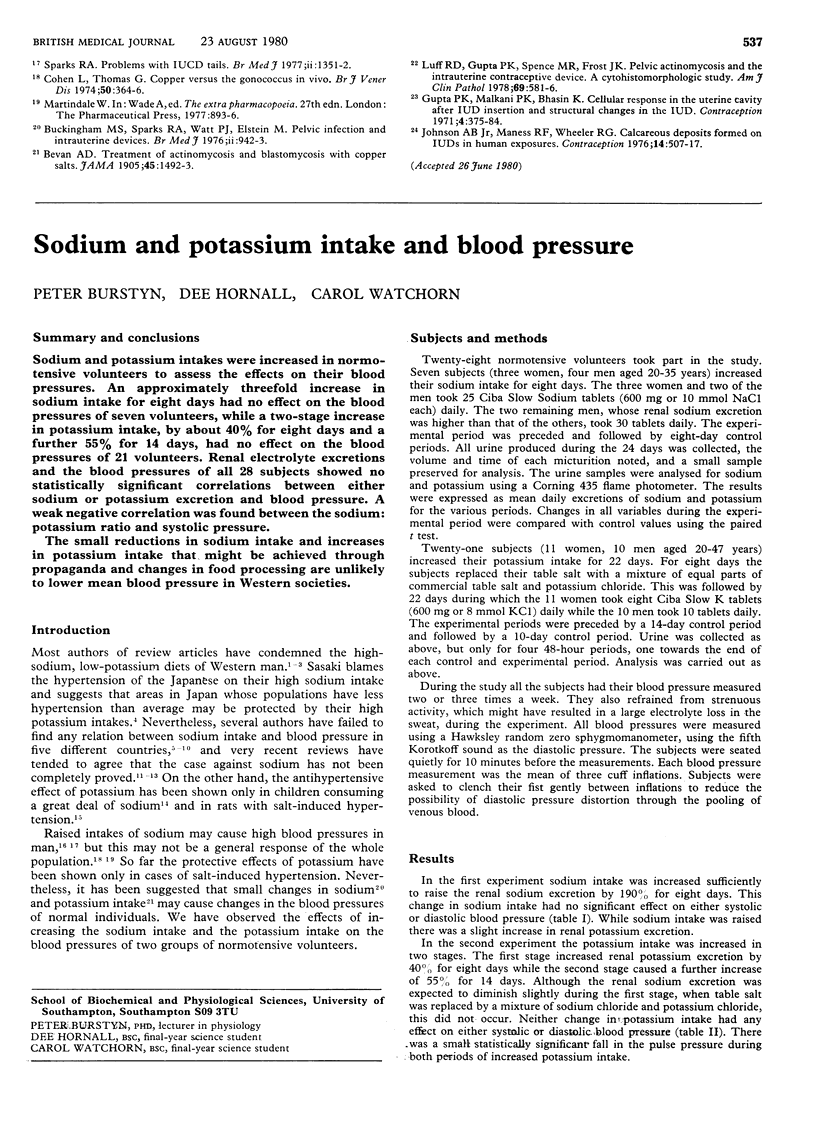
Images in this article
Selected References
These references are in PubMed. This may not be the complete list of references from this article.
- Bhagavan B. S., Gupta P. K. Genital actinomycosis and intrauterine contraceptive devices. Cytopathologic diagnosis and clinical significance. Hum Pathol. 1978 Sep;9(5):567–578. doi: 10.1016/s0046-8177(78)80137-3. [DOI] [PubMed] [Google Scholar]
- Buckingham M. S., Sparks R. A., Watt P. J., Elstein M. Pelvic infection and intrauterine devices. Br Med J. 1976 Oct 16;2(6041):942–943. doi: 10.1136/bmj.2.6041.942-d. [DOI] [PMC free article] [PubMed] [Google Scholar]
- Charnock M., Chambers T. J. Pelvic actinomycosis and intrauterine contraceptive devices. Lancet. 1979 Jun 9;1(8128):1239–1240. doi: 10.1016/s0140-6736(79)91917-2. [DOI] [PubMed] [Google Scholar]
- Cohen L., Thomas G. Copper versus the gonococcus in vivo. Br J Vener Dis. 1974 Oct;50(5):364–366. doi: 10.1136/sti.50.5.364. [DOI] [PMC free article] [PubMed] [Google Scholar]
- Gupta P. K., Erozan Y. S., Frost J. K. Actinomycetes and the IUD: an update. Acta Cytol. 1978 Sep-Oct;22(5):281–282. [PubMed] [Google Scholar]
- Gupta P. K., Hollander D. H., Frost J. K. Actinomycetes in cervico-vaginal smears: an association with IUD usage. Acta Cytol. 1976 Jul-Aug;20(4):295–297. [PubMed] [Google Scholar]
- Hager W. D., Majmudar B. Pelvic actinomycosis in women using intrauterine contraceptive devices. Am J Obstet Gynecol. 1979 Jan 1;133(1):60–63. doi: 10.1016/0002-9378(79)90413-7. [DOI] [PubMed] [Google Scholar]
- Johnson A. B., Jr, Maness R. F., Wheeler R. G. Calcareous deposits formed on IUDs in human exposures. Contraception. 1976 Nov;14(5):507–517. doi: 10.1016/0010-7824(76)90002-0. [DOI] [PubMed] [Google Scholar]
- Jones M. C., Buschmann B. O., Dowling E. A., Pollock H. M. The prevalence of actinomycetes-like organisms found in cervicovaginal smears of 300 IUD wearers. Acta Cytol. 1979 Jul-Aug;23(4):282–286. [PubMed] [Google Scholar]
- Lomax C. W., Harbert G. M., Jr, Thornton W. N., Jr Actinomycosis of the female genital tract. Obstet Gynecol. 1976 Sep;48(3):341–346. [PubMed] [Google Scholar]
- Luff R. D., Gupta P. K., Spence M. R., Frost J. K. Pelvic actinomycosis and the intrauterine contraceptive device. A cyto-histomorphologic study. Am J Clin Pathol. 1978 Jun;69(6):581–586. doi: 10.1093/ajcp/69.6.581. [DOI] [PubMed] [Google Scholar]
- McCormick J. F., Scorgie R. D. Unilateral tubo-ovarin actinomycosis in the presence of an intrauterine device. Am J Clin Pathol. 1977 Nov;68(5):622–626. doi: 10.1093/ajcp/68.5.622. [DOI] [PubMed] [Google Scholar]
- Osser S., Gullberg B., Liedholm P., Sjöberg N. O. Risk of pelvic inflammatory disease among intrauterine-device users irrespective of previous pregnancy. Lancet. 1980 Feb 23;1(8165):386–388. doi: 10.1016/s0140-6736(80)90942-3. [DOI] [PubMed] [Google Scholar]
- Purdie D. W., Carty M. J., McLeod T. I. Tubo-ovarian actinomycosis and the IUCD. Br Med J. 1977 Nov 26;2(6099):1392–1392. doi: 10.1136/bmj.2.6099.1392. [DOI] [PMC free article] [PubMed] [Google Scholar]
- Schiffer M. A., Elguezabal A., Sultana M., Allen A. C. Actinomycosis infections associated with intrauterine contraceptive devices. Obstet Gynecol. 1975 Jan;45(1):67–72. [PubMed] [Google Scholar]
- Sparks R. A. Problems with IUCD tails. Br Med J. 1977 Nov 19;2(6098):1351–1352. doi: 10.1136/bmj.2.6098.1351-e. [DOI] [PMC free article] [PubMed] [Google Scholar]
- Spence M. R., Gupta P. K., Frost J. K., King T. M. Cytologic detection and clinical significance of Actinomyces israelii in women using intrauterine contraceptive devices. Am J Obstet Gynecol. 1978 Jun 1;131(3):295–298. doi: 10.1016/0002-9378(78)90604-x. [DOI] [PubMed] [Google Scholar]
- Tatum H. J., Schmidt F. H., Phillips D., McCarty M., O'Leary W. M. The Dalkon Shield controversy. Structural and bacteriological studies of IUD tails. JAMA. 1975 Feb 17;231(7):711–717. doi: 10.1001/jama.231.7.711. [DOI] [PubMed] [Google Scholar]
- Weström L., Bengtsson L. P., Mårdh P. A. The risk of pelvic inflammatory disease in women using intrauterine contraceptive devices as compared to non-users. Lancet. 1976 Jul 31;2(7979):221–224. doi: 10.1016/s0140-6736(76)91025-4. [DOI] [PubMed] [Google Scholar]




